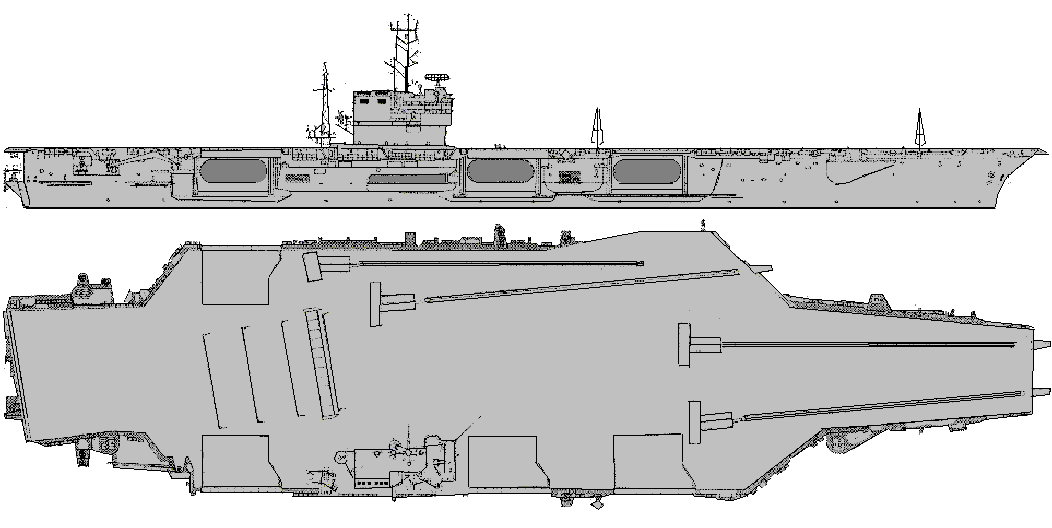
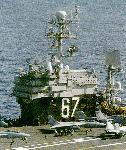
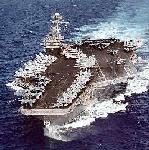

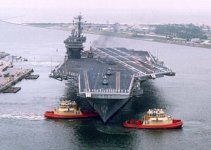

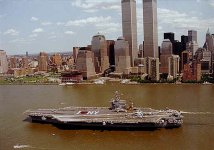





 USS JOHN F. KENNEDY (CV 67) was named for the 35th President of the United States. The
ship's keel was laid October 22, 1964, at the Newport News Shipbuilding and Drydock Company
in Virginia. President Kennedy's nine-year-old daughter, Caroline christened the ship in May
1967 in ceremonies held at Newport News, Virginia; the ship subsequently entered naval
service on September 7, 1968. KENNEDY was originally designed as a CVA-67, attack aircraft carrier. In the early 1970's, the classification was changed to CV-67, indicating the ship was capable of supporting anti-submarine warfare aircraft, making it an all-purpose, multi-mission aircraft carrier.
USS JOHN F. KENNEDY (CV 67) was named for the 35th President of the United States. The
ship's keel was laid October 22, 1964, at the Newport News Shipbuilding and Drydock Company
in Virginia. President Kennedy's nine-year-old daughter, Caroline christened the ship in May
1967 in ceremonies held at Newport News, Virginia; the ship subsequently entered naval
service on September 7, 1968. KENNEDY was originally designed as a CVA-67, attack aircraft carrier. In the early 1970's, the classification was changed to CV-67, indicating the ship was capable of supporting anti-submarine warfare aircraft, making it an all-purpose, multi-mission aircraft carrier.
In September 1995, the USS John F. Kennedy became the Naval Reserve's first aircraft carrier. Homeported at Mayport, FL, her primary function during contingency operations is to provide a surge capability, and in peacetime to support Navy force training requirements. As with all other Reserve ships, she remained fully mission ready.
Since the Bottom-Up Review in 1993, the Defense Department routinely categorized the aircraft carrier force structure as consisting of 11 active carriers and one operational reserve/training carrier. In response to Quadrennial Defense Review analyses and a six-month deployment in 1997 with an active air wing, DoD reevaluated the concept of employing the John F. Kennedy (CV-67) primarily as an operational reserve/training carrier. As a result, this carrier was fully integrated into the active fleet�s deployment schedule, while still functioning as a reserve and training asset when not operating in forward areas.
KENNEDY spent the winter of 1984 in drydock at the Norfolk Naval Shipyard for complex overhaul. KENNEDY departed Norfolk, Virginia, for her 12th major deployment to the Mediterranean in August 1988. On January 4, 1989, while conducting routine operations in international waters, F-14s from the embarked air wing shot down two Libyan MIG-23s that were approaching the battle group in a hostile manner. In the spring of 1989, the ship entered Norfolk Naval Shipyard for a short industrial period.On January 16, 1991, aircraft from the ship's Carrier Air Wing THREE began Operation Desert Storm with attacks on Iraqi forces. The ship launched 114 strikes and 2,895 sorties, with the aircrews of CVW-3 flying 11,263 combat hours and delivering more than 3.5 million pounds of ordnance in the conflict. After the cease fire, KENNEDY transited the Suez Canal for the fourth time in seven months and began her journey home. KENNEDY arrived in its homeport of Norfolk on March 28, 1991, to enter a four-month shipyard restricted availability at Norfolk Naval Shipyard. The ship departed the shipyard at the end of September with extensive repairs and maintenance accomplished on engineering systems, flight deck systems and equipment.
The 1991 Defense Base Closure and Realignment Commission recommended that the Philadelphia Naval Shipyard [PNSY] be closed but acknowledged that PNSY would perform the Service Life Extension Program for the USS. Kennedy from September 1993 until mid-1996. The work on the USS. Kennedy subsequently changed to a 24-month complex overhaul, which Congress required to be performed by PNSY. The Secretary of Defense concurred in this plan in September 1991. KENNEDY completed a two-year comprehensive overhaul in the Philadelphia Naval Shipyard on September 13, 1995. Following the overhaul, KENNEDY moved to its new homeport at the Mayport Naval Staion in Mayport, Florida. Kennedy returned home October 28, 1997 after six months of deployment in the Mediterranean Sea, the Adriatic Sea in support of Operation Deliberate Guard, and the Arabian Gulf supporting Operation Southern Watch. As the sole conventionally powered aircraft carrier in the Atlantic Fleet, JFK deployed with the most advanced command, control, communications, computers and information systems (C4I) in the Navy.Specifications | |
| Power Plant | Eight boilers, four shafts, 280,000 total shaft horsepower |
| Length, overall | 1052 feet (315.6 meters) |
| Flight Deck Width | 252 feet (76.8 meters) |
| Beam | 130 feet (39.6 meters) |
| Displacement | 82,000 tons (full load) |
| Speed | 30+ knots (34.5 miles per hour) |
| Aircraft | Approximately 85 |
| Crew | Ship's Company: 3,117 - Air Wing 2,480 |
| Armament |
Sea Sparrow missiles 3 Phalanx CIWS 20mm mounts |
| Combat Systems |
SPS-43 SPS-48C 3 Mk91 Fire Control SLQ-29 EW WLR- 1 ESM WLR-11 ESM |
| Unit Operating Cost Annual Average | ~$120,000,000 [source: [FY1996 VAMOSC] |
Ships | ||||||
| Name | Number | Builder | Homeport | Ordered | Commissioned | Decommissioned |
| John F. Kennedy | CV-67 | Newport News | Mayport | 30 Apr 1964 | 07 Sep 1968 | 2018 |







